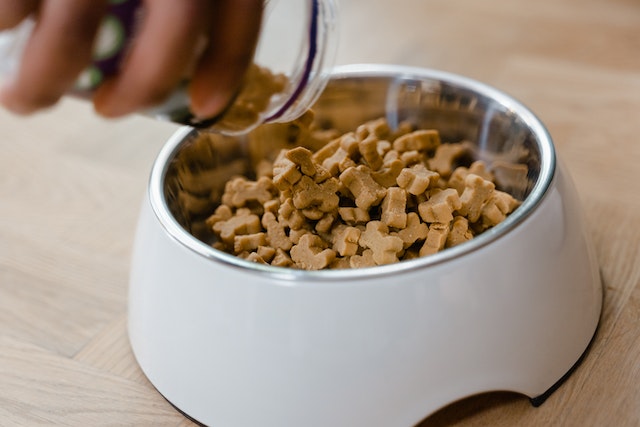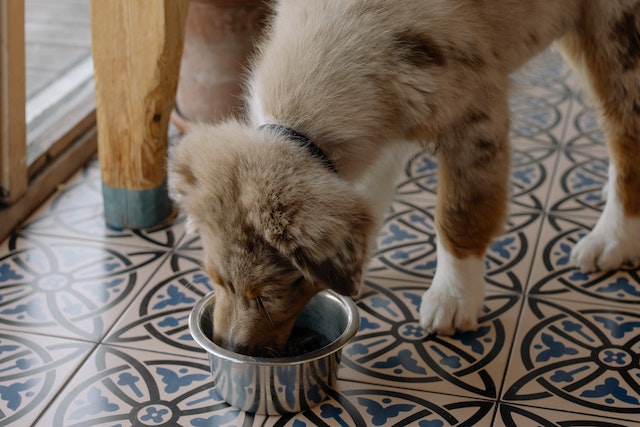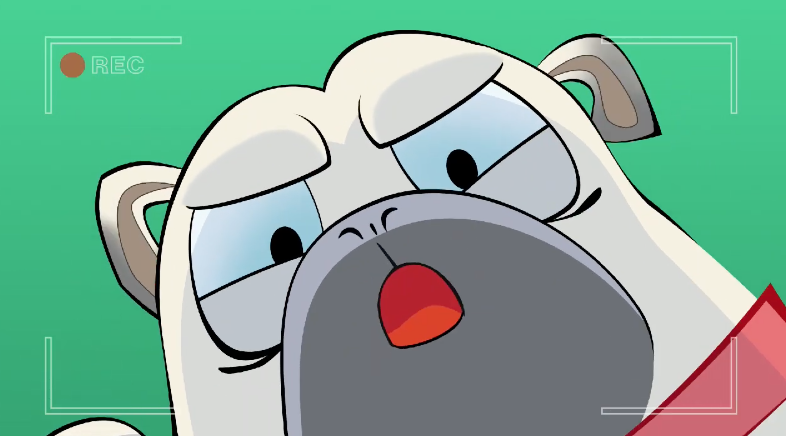

From Puppy Food to Adult Food: How and When to Switch
Puppies need a special diet before they’ve reached maturity. Different breeds, however, reach maturity at different points. Here’s a guide to help you carefully plan when and how to make the transition from puppy food to adult dog food.

Writer Animalia Team
6 min read

Puppies need a special diet before they’ve reached maturity. Different canine breeds, however, reach maturity at different points so it can sometimes be hard to know when exactly to make the switch. Advice from your veterinarian as well as research and close observations of your dog’s health, behavior and appetite can help guide you.
Transitioning at the appropriate time is important. Change your dog’s diet too soon and your puppy will miss out on the vital nutrients contained in its specialized food. Do it too late and your canine may become obese as a result of too much calorie-dense puppy food. Obesity is one of the most common nutritional issues for dogs and obese dogs are more likely to suffer a range of additional health concerns. That’s all the more reason to carefully plan the transition from puppy food to adult dog food.
What is the difference between puppy food and adult dog food?
During their first few months of life, your puppy will grow at a remarkable rate – especially if you’ve chosen a large- or giant-breed dog. To maintain this rate of growth, puppies need a diet that contains lots of protein, fat, and calories as well as specific nutrients that help their bones, organs, muscles, and joints develop. Some types of puppy food also contain DHA, a substance found in their mother’s milk. DHA aids in both brain development and function. Depending on the breed, a dog’s nutritional needs will gradually change over time.

Why do I need to switch: Why is adult food important?
A growing puppy needs more calories and a different blend of nutrients than a growing dog. All those calories can lead to weight gain and related issues if dogs eat puppy food into adulthood. Dogs are also typically spayed or neutered once they’ve reached sexual maturity. After these procedures, a dog’s caloric needs will decrease significantly. By swapping to a complete and balanced adult dog food, you’ll keep your pet in tip-top shape while helping it to maintain a healthy weight.:
When is the best age to make the switch?
Puppies need a complete and balanced puppy food until they reach maturity. Although dogs who are one year or older are often considered adults, this isn’t always the case. The point at which a dog reaches maturity or adulthood varies from breed to breed. Generally, giant-breed dogs take longer to mature and will need to stay on a puppy diet for longer than small to medium-sized breeds.If you’re not sure when your dog will reach maturity, check out our guide below or have a chat with your vet.
Here’s how long to feed puppy food based on breed sizes:
- Toy- and small-breed dogs: Toy breeds include the Chihuahua, Brussels Griffon, and Maltese while small breeds include dogs like the Beagle, Australian Terrier, West Highland White Terrier, and Cavalier King Charles Spaniel. They very often weigh less than 20 pounds and reach maturity between nine to 10 months of age
- Medium breeds: Popular medium-sized dog breeds include the Basset Hound, Chow Chow, Alaskan Malamute, American Staffordshire Terrier, and Border Collie. They weigh in at between 21 and 50 pounds when fully grown and mature at around one year of age
- Large breeds: These dogs can reach weights of up to 80 pounds and take between 12 to 16 months to reach maturity. Examples of large breeds are the Afghan Hound, Doberman Pinscher, Saluki, and Spanish Mastiff
- Giant breeds: Giant-breed dogs mature at the slowest rate of all and can take between 18 months and 2 years to reach adulthood, by which time they can weigh up to 120 pounds or more. Among these gentle giants of the dog world are the Anatolian Shepherd, Great Dane, Irish Wolfhound, Bernese Mountain Dog, and Saint Bernard
Your puppy will also start giving you clues that they’re ready to swap to adult meals. They may start skipping meals or leaving behind some leftovers instead of gobbling down a full bowl. As their calorie needs decrease, they’ll feel full even though they’re eating less.
A step-by-step guide to making the switch
With their high metabolism, energy needs, and fast growth rate, puppies typically need to eat three times a day. Once they reach maturity and require fewer calories, this can be cut back to twice a day. If they’re not emptying their bowl on a regular basis, this could signal that the time to make the switch has arrived. Making a successful switch should take between seven and 10 days so make sure your schedule allows for this. Taking time to make the switch gradually should prevent an upset stomach and other potential complications. Choose good-quality adult dog food and follow the guide below. When the transition is complete, split this amount equally between two meals.
- Days one and two: Serve 3/4 of the puppy food you’d normally serve and add 1/4 of adult food
- Days three and four: Serve half adult food and half puppy food
- Days five and seven: Give a mix of 3/4 food for adult dogs and 1/4 food for puppies
- Days eight and onwards: Your pet should now be eating 100% adult food
What to do if problems arise
By making these changes gradually, you should avoid any serious health or behavioral problems. Make the changes too rapidly and your pet could suffer from gastrointestinal issues such as vomiting, diarrhea, or a combination of the two. Such experiences will prove uncomfortable for them and unpleasant for you both. This could also have the effect of creating an association between the new food and pain or discomfort, making your dog reluctant to eat it.
If your dog experiences vomiting, make sure they drink plenty of water and avoid feeding them again until their condition has improved. During this transition period, it’s very important to monitor your dog’s response carefully which is why having someone at home during this sensitive period is a good idea. If problems do arise or your pet appears picky about the new food, try extending the transition period. This should help them become accustomed to the change. If problems continue, try changing the brand of dog food or reaching out to your vet for their advice.





We offer the most
comprehensive coverage
out there
car with a spare tire for life’s bumps.
Having Animalia is like a pimped-out
Rolls Royce with a swimming pool
in the trunk.



Get your pet insurance quote
Pet type
- Dog
- Cat




